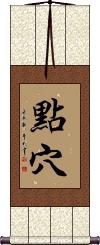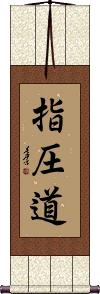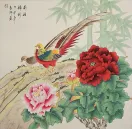Many custom options...
And formats...

Not what you want?
Try other similar-meaning words, fewer words, or just one word.
Feel free to email me with your request. If it's easy, I'll translate it for free and add it to this database of calligraphy for you.
Pressure Points in Chinese / Japanese...
Buy a Pressure Points calligraphy wall scroll here!
Personalize your custom “Pressure Points” project by clicking the button next to your favorite “Pressure Points” title below...
Pressure Points
點穴 means pressure points in Chinese and Japanese.
In martial arts, this term refers to hitting a pressure point or vulnerable body cavity. 點穴 is not the term “dim mak,” but it is often used in place of or with dim mak.
In medical terms, these are just pressure points, which can be places for acupuncture or the application of moxibustion.
See Also: Dim Mak
Shiatsu-Do
指圧道 is the title for Shiastu-Do, the Japanese way of finger pressure.
Shitsu-Do is about applying special finger pressure to points on the body thought to be connected to pathways called “meridians.” Shiatsu is a healthful way to get your 気 or 氣 (ki energy) flowing properly.
Note: This title can also be written in the older 指壓道 form (just the middle character has an ancient/traditional form used before WWII).
You might even see 指压道 which uses the Simplified Chinese form of the second character.
This in-stock artwork might be what you are looking for, and ships right away...
Gallery Price: $63.00
Your Price: $35.00
Not the results for Pressure Points that you were looking for?
Below are some entries from our dictionary that may match your Pressure Points search...
| Characters If shown, 2nd row is Simp. Chinese |
Pronunciation Romanization |
Simple Dictionary Definition |
點穴 点穴 see styles |
diǎn xué dian3 xue2 tien hsüeh tenketsu てんけつ |
More info & calligraphy: Pressure Points(out-dated kanji) (1) pressure points (e.g. for application of moxa); (2) (martial arts term) vulnerable body cavities |
点穴 see styles |
tenketsu てんけつ |
More info & calligraphy: Pressure Points |
點按 点按 see styles |
diǎn àn dian3 an4 tien an |
(computing) to tap (on a touchscreen); to click (with a mouse); (massage) to apply focused pressure to specific points on the body |
Variations: |
tenketsu てんけつ |
(1) pressure points (e.g. for application of moxa); (2) {MA} vulnerable body cavities |
The following table may be helpful for those studying Chinese or Japanese...
| Title | Characters | Romaji (Romanized Japanese) | Various forms of Romanized Chinese | |
| Pressure Points | 點穴 点穴 | tenketsu | diǎn xué / dian3 xue2 / dian xue / dianxue | tien hsüeh / tienhsüeh |
| Shiatsu-Do | 指圧道 | shiatsudou / shiatsudo | ||
| In some entries above you will see that characters have different versions above and below a line. In these cases, the characters above the line are Traditional Chinese, while the ones below are Simplified Chinese. | ||||
Successful Chinese Character and Japanese Kanji calligraphy searches within the last few hours...







